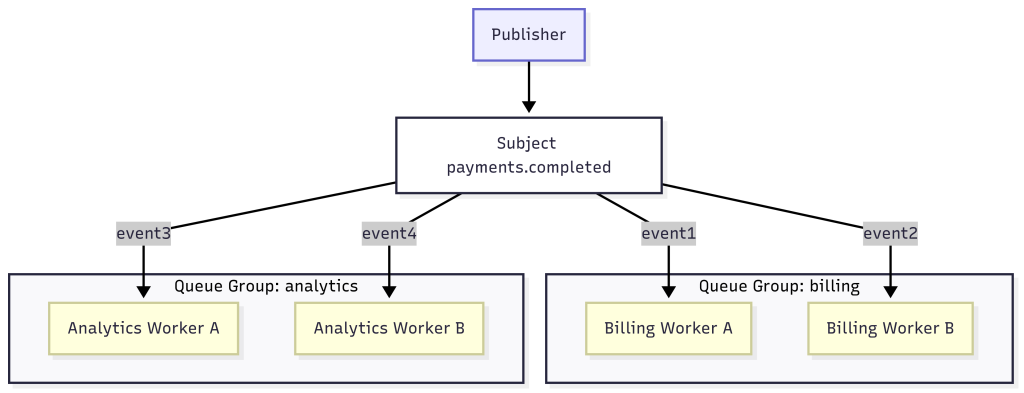Use Case Examples

- Email Sending Service
- Subject:
email.send - Queue group:
mailers - Multiple worker instances subscribe to
mailers. Each email task goes to one worker only.
- Subject:
- Payment Processing
- Subject:
payments.completed - Queue group:
payment-workers - NATS distributes payment events across a pool of workers for faster throughput.
- Subject:
- IoT Device Commands
- Subject:
devices.cmd - Queue group:
device-controllers - Only one controller handles a device command at a time.
- Subject:
Queue Groups vs Kafka Consumer Groups
If you’ve worked with Kafka before, Queue Groups in NATS will feel familiar. Both concepts aim to distribute messages across multiple consumers. But there are some important differences:
| Aspect | NATS Queue Groups | Kafka Consumer Groups |
|---|---|---|
| Setup | Very lightweight, no extra configuration | Heavier setup, needs brokers and Zookeeper/Kraft |
| Delivery | Messages go to exactly one subscriber in the group | Each partition is assigned to exactly one consumer in the group |
| Persistence | Ephemeral (messages not stored) unless combined with JetStream | Persistent by default, stored on disk |
| Scaling | Add or remove workers anytime, messages are load balanced automatically | Scaling tied to number of partitions; can’t have more active consumers than partitions |
| Use Case | Real-time load balancing of tasks and jobs | Durable processing of event streams with ordered partitions |
Example Perspective
- NATS Queue Group:
Imagine an email sending service. Publishers push email tasks toemail.send. Multiple workers in themailersgroup share the load. If a worker is down, others pick up the tasks. - Kafka Consumer Group:
Imagine a stream of e-commerce orders. The topic has 6 partitions. A consumer group with 6 members can process them in parallel, each consumer handling one partition. Messages are stored on disk and can be replayed later.
Final Thoughts
Queue Groups in NATS give you simple yet powerful load balancing. They work naturally with subjects, and you don’t need to configure anything complex. Just join workers under the same group name, and NATS does the rest.
Pages: 1 2
Category: NATS
